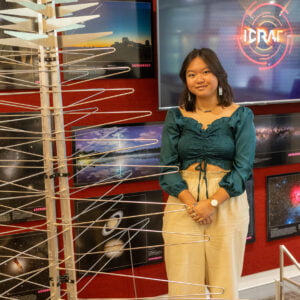Introduction
 The work experience that I went to lasted for 5 days (September 20th – 24th) with 3 other year 10s from different schools. During this week, we talked to a wide range of people from students to researchers in different fields.
The work experience that I went to lasted for 5 days (September 20th – 24th) with 3 other year 10s from different schools. During this week, we talked to a wide range of people from students to researchers in different fields.
Day 1 – Curtin
We started the day by talking to Adelle. She talked about what a typical day would look like for her, starting with going on arXiv to read about new research published recently. After the introduction, we talked to Mawson about his PhD on theorising how fast radio burst (FRB) works. Afterwards, we talked to Maria about antenna designs and different shapes can pick up different frequency radio waves. Before lunch, we listened to Mawson do his milestone presentation, he talked more about how light is bent because of refraction through FRB.
After lunch, we talked to Kat about her PhD on young galaxies. Then, she proceeded to teach us basic coding using Python and uses Pokémon as examples. Next, we talked to Cath who leads the Epoch research. The main goal of Epoch is to find out how the first stars were made and use stimulations to see the change in chemical compositions over time. The last thing we did was talking to Dev about the coding side of the SKA. They gave us a presentation on what they do, which is coding for supercomputers to process information.
Day 2 – UWA
We started the day with a zoom meeting with Kevin and told us a bit more information about ICRAR. Its main goal is to build the SKA. It can pick up radar from 10 light-years away and it is built on the Shrine of Murchison because of its low population density. It uses 100 times the global internet traffic to create images. Following the meeting, we got taught how to calculate the mass of a galaxy using trigonometry.
After lunch, we talked to Elisabete about galaxy evolution, gravitational waves, and gravitational lensing. Later, we talked to Luca about doing research on different types of telescopes as different telescopes are used to see different gases and elements. Subsequently, we met Skevos who is a PhD student in physics and shows us around the physics lab that’s currently running experiments to transmit data through lasers. He also showed us an optical telescope that they are currently working on.
Day 3 – Curtin & Pawsey Supercomputing Centre
We started the day at CSIRO listening to Eamonn giving us a presentation on quantum physics. We learned about quantum teleportation, superposition, and quantum computing. Quantum field theory is the greatest, most accurate depiction of the universe. Superposition is when something is a particle and a wave and can be at many places at once, like light. Quantum computers are strong as they are fast and unhackable, but one of their setbacks is that you can’t use the copy and paste command.
After lunch, we went to Pawsey Supercomputing centre to see the new supercomputer that they recently installed. Setonix has 50 petaflops of power. It produces so much heat that water from the cooling system goes in at 20 degrees and come out at 48 degrees.
Day 4 – Curtin
We started the day by talking to Kat and gave us a mission. We received data from Murchison Widefield Array (MWA) and have to figure out what was causing interference in the data. MWA is a radio telescope, so the interference was caused by radio frequencies, such as planes, satellites, etc. We used satellite trackers and Google to try to track down what may be causing the interference.
After lunch, we talked to Adela about white dwarfs. They are dense stars that are leftover cores after burning out of nuclear fuel. They have a lower temperature as they can’t burn anymore with an iron core. The bigger the radius, the smaller the mass. 20% of white dwarfs have magnetic fields.
Day 5 – UWA
We started the day by talking to Danail about his experience on Zero-G which you can experience weightlessness without going to space. People do experiments on it as it is a cheaper alternative than going to space. When we are done with afternoon tea, we watched a video on cosmology. Cosmology is the study of the universe to understand our fate. I learned that the universe was flat which then took a lot of explaining from Gregory for me to fully grasp the concept.
After lunch, we had the opportunity to build a SKA prototype which Greg only revealed later that the prototype costs around $2000. Apparently, I had the biggest smile when I found out we can build one. We learned that only the antennas at the top are solid as they are more expensive and can detect higher frequency, suitable for the research for the first stars.
Conclusion
All in all, I had a great time here at ICRAR and am honestly sad that the week ended so soon. I highly encourage anyone that has even the slightest interest in astronomy to come to do work experience here as you can hear from so many different people and realise astronomy isn’t just looking through a telescope. The friendships you form with other work experience students are also rewarding. Thank you to everyone that made my time and ICRAR such a wonderful experience.